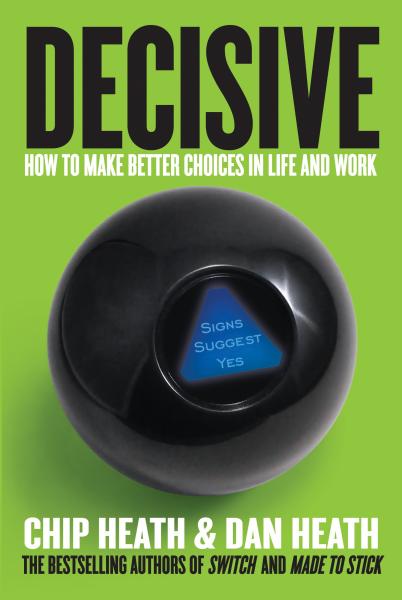Wi9 Plenary Speaker Dan Heath on Reality-Testing Your Assumptions
- By Dan Cullen
 The opening plenary speaker for Winter Institute 2014 will be bestselling author Dan Heath, who will talk about why so many critical business decisions are flawed, and — more importantly — how booksellers can do better.
The opening plenary speaker for Winter Institute 2014 will be bestselling author Dan Heath, who will talk about why so many critical business decisions are flawed, and — more importantly — how booksellers can do better.
Here’s the second in a series of key insights and tips from Decisive, in anticipation of a plenary talk that will do much to answer the question of how we can make better choices in life and work.
Dan Heath and his brother, Chip, are the co-authors of the bestselling business book Decisive (Crown Business), which explores key aspects of the decision-making process and offers insightful strategies and practical tools to help individuals and businesses make better decisions.
 A key concept regarding decision-making in Chip and Dan Heath’s Decisive is what they term the WRAP process. As they point out, to make better choices, we must avoid the most common decision-making biases. Simple awareness often is not sufficient to avoid them, but a process can help. The WRAP process is a big asset in making better, bolder decisions.
A key concept regarding decision-making in Chip and Dan Heath’s Decisive is what they term the WRAP process. As they point out, to make better choices, we must avoid the most common decision-making biases. Simple awareness often is not sufficient to avoid them, but a process can help. The WRAP process is a big asset in making better, bolder decisions.
The Wrap Framework
- Widen Your Options
- Reality-Test Your Assumptions
- Attain Some Distance Before Deciding
- Prepare to Be Wrong
Step 2: Reality-Test Your Assumptions
When we’re weighing multiple options, we’ll go looking for information to help us make the choice. But there’s a problem: We tend to look for information that supports what we want to be true. That’s called the “confirmation bias” — the tendency to seek out information that confirms our existing beliefs or preferences. To make better decisions, though, we’ve got to look beyond self-serving information and make an attempt to “reality-test” the assumptions we’re making.
Here are three strategies for doing that:
First, develop the discipline to consider the opposite of your instinct. If you think Jane is the right person to be your new frontlist buyer, consider why she might be exactly wrong. You also want your employees to help you ‘consider the opposite’ of important strategic decisions; they might suppress their concerns for political reasons. Create a forum where it’s safe for people to air their concerns with the direction you’re going. Or, deputize a small team to compile a “devil’s advocate” case against a new initiative being considered.
Second, trust the experience of others over your own guesses. For instance, if we’re looking for a new restaurant, we might turn to Yelp, knowing that if a particular restaurant earned a 4.5-star average across 200 reviews, it’s going to be a great experience. It would be arrogant to think we could glance at the restaurant’s menu and website and conclude that we know more than those 200 prior diners. But we make that mistake all the time inside organizations — we’ll undertake new ideas or new initiatives without seeking out the experiences of people who’ve endured them before. For instance, if you’re considering a new software application, you’d be wise to seek out the “reviews” of 10 other bookstores who are using it. (Or even better, find bookstores that abandoned it. That will give you disconfirming information.)
And, third, the ultimate reality-testing is to “ooch,” which means running small experiments to test our theories. Rather than jumping in headfirst, dip a toe in. As one example, we can “ooch” when we hire new employees. Instead of deciding who to hire based on interviews, could you give them a three-week trial contract and see how they actually perform in your store? When we ooch, we stop trying to guess which option is best and instead set up experiments that give us real-world evidence.

